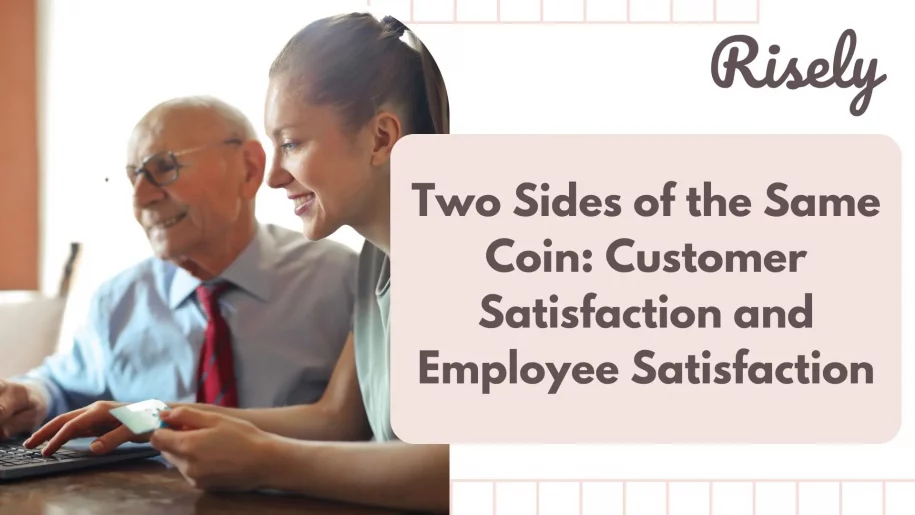Two Sides of the Same Coin: Customer Satisfaction and Employee Satisfaction
In the ever-evolving landscape of business success, two essential elements stand at the forefront: customer satisfaction and employee satisfaction. While these concepts may appear distinct, they are intrinsically linked by a powerful, often underestimated force—their interdependence. This blog will discuss the intricate relationship between customer satisfaction and employee satisfaction—a partnership that fuels the success of organizations across industries. In this blog, we will embark on a journey to unveil the profound impact that happy employees and satisfied customers have on businesses’ growth, reputation, and overall prosperity.- Two Sides of the Same Coin: Customer Satisfaction and Employee Satisfaction
- What is customer satisfaction? Why is it important?
- What is employee satisfaction? Why is it important?
- What is the relationship between customer satisfaction and employee satisfaction?
- Ways customer satisfaction leads to employee satisfaction
- Tips for customer satisfaction and employee satisfaction
- Conclusion
What is customer satisfaction? Why is it important?
Customer satisfaction refers to the degree of contentment and fulfillment experienced by customers when interacting with a company’s products, services, or overall brand. It encompasses their perception of the quality, value, and overall experience they receive. Customer satisfaction is paramount because it directly impacts a business’s success and sustainability. Satisfied customers are more likely to become loyal, repeat customers, recommend the company to others, and provide valuable feedback. High customer satisfaction fosters customer retention, enhances brand reputation, and can lead to increased profitability through repeat business and reduced marketing costs. Moreover, in today’s interconnected world, where customer reviews and recommendations are widely accessible, maintaining high levels of customer satisfaction is critical to staying competitive and thriving in the marketplace.What is employee satisfaction? Why is it important?
Employee satisfaction refers to the overall contentment, happiness, and fulfillment employees experience in their work environment. It encompasses their perceptions of job conditions, workplace culture, relationships with colleagues and supervisors, compensation, and opportunities for growth and development. Employee satisfaction is critically important because it directly impacts various aspects of an organization’s success. Satisfied employees tend to be more engaged, motivated, and productive. They are also more likely to stay with the company, reducing employee turnover rates and the associated recruitment and training costs. Moreover, a satisfied workforce contributes to a positive workplace culture, attracting top talent, enhancing collaboration, and improving overall organizational performance.What is the relationship between customer satisfaction and employee satisfaction?
Customer satisfaction and employee satisfaction are often described as a “virtuous cycle” or a mutually reinforcing loop. Here’s how they are interconnected:- Employee satisfaction drives customer satisfaction: Satisfied and engaged employees provide better customer service. They are more likely to be attentive, helpful, and empathetic when interacting with customers. Happy employees are motivated to go the extra mile to meet customer needs, leading to higher customer satisfaction levels.
- Positive work environment: Employee satisfaction often reflects the workplace culture and environment. A positive work culture characterized by respect, collaboration, and support tends to translate into employees who treat customers with similar respect and courtesy.
- Productivity and service quality: Satisfied employees are typically more productive and committed. This increased productivity can result in higher service quality and efficiency, directly benefiting customers.
- Reduced turnover: High employee satisfaction is associated with lower turnover rates. Employees who stay longer with a company gain more experience and expertise, leading to better service delivery and customer interactions.
- Feedback loop: Employee feedback is a valuable source of insights for improving customer experiences. Satisfied employees are more likely to provide constructive feedback on customer-related issues, helping the organization make necessary improvements.
- Enhanced problem-solving: Satisfied employees are often better equipped to effectively handle and resolve customer complaints or issues. They are more resilient in challenging situations, which can lead to better problem-solving and conflict resolution.
- Brand advocacy: Employees who are highly satisfied with their organization are more likely to become brand advocates. They may recommend the company’s products or services to friends, family, and acquaintances, indirectly influencing potential customers.
- Financial impact: Research has shown a strong correlation between employee satisfaction, customer satisfaction, and financial performance. Organizations that prioritize both employee and customer satisfaction tend to outperform their competitors.
Other Interesting Reads
Ways customer satisfaction leads to employee satisfaction
In the BPO industry, the relationship between customer satisfaction and employee satisfaction is interdependent. Here are ways in which customer satisfaction can lead to employee satisfaction in the BPO sector:- Recognition and appreciation: When BPO employees receive positive feedback from satisfied customers, it reinforces their sense of accomplishment and value. Knowing their efforts contribute to customer happiness can boost employee morale and job satisfaction.
- Reduced stress: Satisfied customers are less likely to raise complaints or escalate issues. As a result, BPO employees experience lower stress levels when interacting with content and happy customers, contributing to a more positive work environment.
- Enhanced job security: Higher levels of customer satisfaction often lead to client retention and contract renewals. When BPO employees see stable client relationships, they feel more secure in their jobs, which can increase their overall job satisfaction.
- Learning and skill development: Satisfied customers may require various services and solutions. BPO employees often need to expand their skills and knowledge to meet these needs. The opportunity for skill development and continuous learning can be rewarding for employees.
- Recognition programs: Some BPO companies have recognition programs that reward employees for outstanding customer service and high customer satisfaction ratings. These programs can boost employee motivation and job satisfaction.
- Positive work environment: High levels of customer satisfaction can create a more stable and positive work environment. Employees are less likely to face challenging or hostile customer interactions, leading to improved job satisfaction.
- Team cohesion: Positive customer feedback can foster a sense of teamwork and camaraderie among BPO employees. Working together effectively to satisfy clients can enhance job satisfaction and a sense of belonging.
- Performance-based incentives: Some BPO organizations offer performance-based incentives tied to customer satisfaction metrics. When employees are rewarded for achieving high customer satisfaction scores, it can motivate them to excel in their roles.
Tips for customer satisfaction and employee satisfaction
Some valuable tips for enhancing both customer satisfaction and employee satisfaction within your organization:For customer satisfaction
- Understand your customers: Invest time in understanding your customers’ needs, preferences, and pain points. Conduct market research and gather feedback to tailor your products and services accordingly.
- Exceptional customer service: Train and empower your teams to provide exceptional support. Encourage active listening and empathy when interacting with customers.
- Consistent communication: Maintain open and transparent communication channels with your customers. Keep them informed about changes, updates, and new offerings.
- Personalization: Customize your offerings and interactions whenever possible. Personalized experiences show customers that you value their individuality.
- Prompt issue resolution: Address customer issues and complaints promptly and professionally. A quick and effective resolution can turn dissatisfied customers into loyal advocates.
- Solicit feedback: Actively seek customer feedback through surveys, reviews, and direct inquiries. Use this feedback to make improvements and show customers that you value their opinions.
For employee satisfaction
- Cultivate a positive work environment: Foster a workplace culture that promotes respect, collaboration, and support. A positive work environment enhances employee morale and job satisfaction.
- Provide growth opportunities: Offer employees training, development programs, and clear career paths. Encourage continuous learning and skill development.
- Recognition and appreciation: Recognize and appreciate employees’ contributions. Whether monetary or verbal, acknowledgment and rewards boost motivation and job satisfaction.
- Work-life balance: Encourage a healthy work-life balance. Support flexible work arrangements and promote employee well-being and mental health.
- Effective leadership: Develop strong leadership skills within your management team. Effective leaders inspire and empower employees, creating a positive work culture.
- Regular feedback: Provide constructive feedback and performance evaluations. Employees value guidance and clarity in their roles.
Conclusion
In the intricate dance between customer satisfaction and employee satisfaction, we’ve uncovered a powerful partnership that lies at the heart of business success. As we draw the curtain on this blog, we’re left with a resounding realization that these two forces are not just connected but inseparable. Customer satisfaction, the beacon of loyalty and advocacy, relies on the dedication and enthusiasm of satisfied employees. These employees, in turn, find fulfillment in delivering exceptional service and witnessing a positive impact on customers. Our blog has revealed that investing in the happiness of your employees pays dividends in the form of satisfied customers who return, recommend, and become your brand’s champions. Likewise, prioritizing customer satisfaction leads to a virtuous cycle where employee morale, productivity, and commitment soar.Ready to unlock the full potential of your organization through improved communication?
Take free assessment on effective communication today and pave the way for enhanced customer and employee satisfaction!
Other Related Blogs
How to Set Effective Learning and Development Goals?
This blog highlights how effective learning and development goals are set, why is setting them important for your organization and what challenges you might face during this process. … Read…
Are you on track to meet your Q1 goals?
Are you on track to meet your Q1 goals? We are in the middle of the first quarter of 2024. Seems hard to believe. It surely is! ⏰ Time has…
5 Secrets Of Solid Goal Setting At Work You Can’t Miss
5 Secrets Of Solid Goal Setting At Work You Can’t Miss “I don’t focus on what I’m up against. I focus on my goals and I try to ignore the…
Understanding the world of Goal Setting Coach to reach new heights
Understanding the world of Goal Setting Coach to reach new heights Setting and achieving goals is essential for personal and organizational success in today’s fast-paced and competitive work environment. However,…


